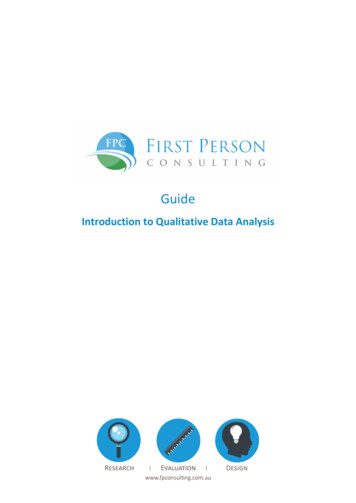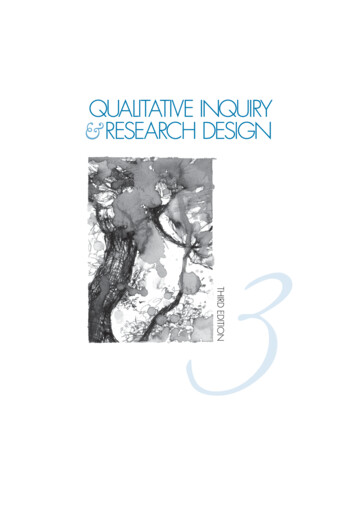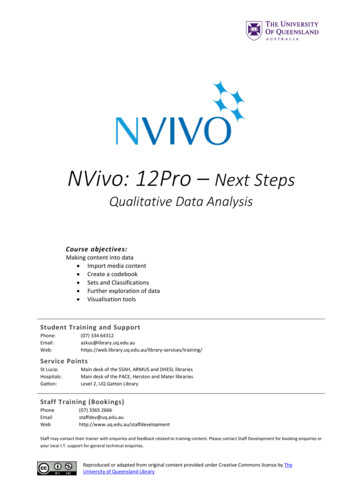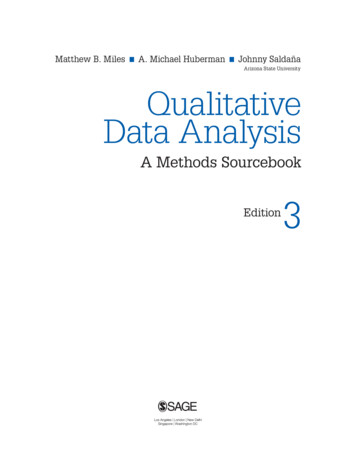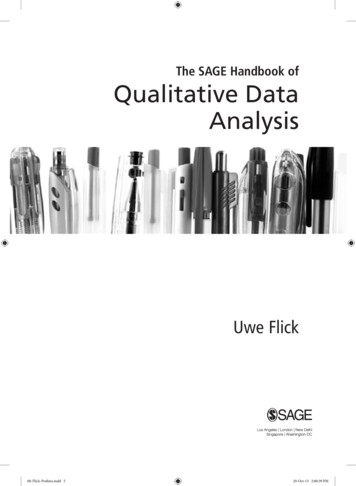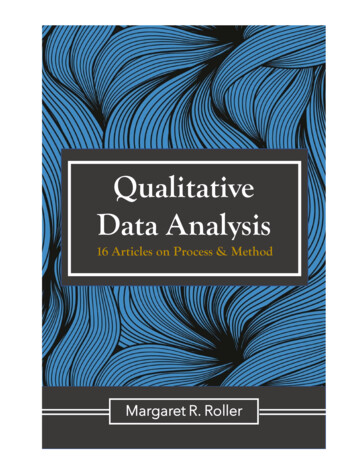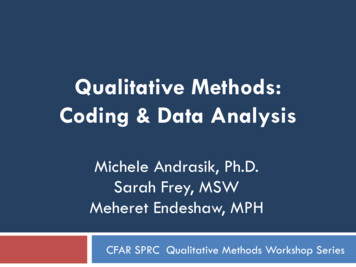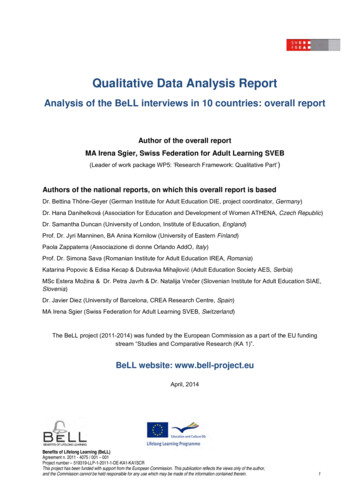
Transcription
Qualitative data analysisLearning how to analyse qualitative data by computer can be fun. That is oneassumption underpinning this new introduction to qualitative analysis, whichtakes full account of how computing techniques have enhanced and transformedthe field. The book provides a practical and unpretentious discussion of themain procedures for analysing qualitative data by computer, with most of itsexamples taken from humour or everyday life. It examines ways in whichcomputers can contribute to greater rigour and creativity, as well as greaterefficiency in analysis. The author discusses some of the pitfalls and paradoxes aswell as the practicalities of computer-based qualitative analysis.The perspective of Qualitative Data Analysis is pragmatic rather thanprescriptive, introducing different possibilities without advocating oneparticular approach. The result is a stimulating, accessible and largely disciplineneutral text, which should appeal to a wide audience, most especially to arts andsocial science students and first-time qualitative analysts.Ian Dey is a Senior Lecturer in the Department of Social Policy and SocialWork at the University of Edinburgh, where he regularly teaches researchmethods to undergraduates. He has extensive experience of computer-basedqualitative analysis and is a developer of Hypersoft, a software package foranalysing qualitative data.
Qualitative data analysisA user-friendly guide for socialscientistsIan DeyLONDON AND NEW YORK
First published 1993by Routledge11 New Fetter Lane, London EC4P 4EESimultaneously published in the USA and Canadaby Routledge29 West 35th Street, New York, NY 10001Routledge is an imprint of the Taylor & Francis GroupThis edition published in the Taylor & Francis e-Library, 2005.“To purchase your own copy of this or any of Taylor & Francis or Routledge’s collection of thousands ofeBooks please go to www.eBookstore.tandf.co.uk.” 1993 Ian DeyAll rights reserved. No part of this book may be reprinted or reproducedor utilised in any form or by any electronic, mechanical, or other means,now known or hereafter invented, including photocopying and recording,or in any information storage or retrieval system, without permission inwriting from the publishers.British Library Cataloguing in Publication DataA catalogue record for this book is available from the British LibraryLibrary of Congress Cataloging in Publication DataA catalog record for this book is available from the Library of CongressISBN 0-203-41249-4 Master e-book ISBNISBN 0-203-72073-3 (Adobe eReader Format)ISBN 0-415-05851-1 (hbk)ISBN 0-415-05852-X (pbk)
ContentsList of figures, illustrations and What is qualitative data?103What is qualitative analysis?314Introducing computers575Finding a focus656Managing data777Reading and annotating878Creating categories1009Assigning categories12010Splitting and splicing13711Linking data16112Making connections17713Of maps and matrices20114Corroborating evidence22715Producing an account24516Conclusion272Appendix 1:‘If the Impressionists had been Dentists’277Appendix 2:Software2811
vGlossary283References285Index288
Figures, illustrations and 28.3The steps involved in data analysis—chapter by chapter8Describing a bit of data as a ripple in the flow of experience19Category relating two similar observations20Categorizing using inclusive categories22Nominal variable with mutually exclusive and exhaustive values23Ordinal variable indicating order between observations24Interval variable with fixed distance between values25Quantitative and qualitative data in dynamic balance30Qualitative analysis as a circular process32Three aspects of description in qualitative analysis33Categorizing as a method of funnelling data44Derivation of nominal variables with exclusive and exhaustive values 47Formal connections between concepts47Formal and substantive connections between building blocks49Connections between chronological or narrative sequences52Causal connections between concepts52Qualitative analysis as a single sequential process54Qualitative analysis as an iterative spiral55A link between text held in separate locations61Deriving hypotheses about humour from the literature72Main themes for analysing humour75Integrating themes around issues of style and substance75Case documents kept in a hierarchical file system83Data stored in fields on a card-based filing system84Relating data to key themes97Mapping ideas to data within and across cases98Relating two ideas98Alternative category lists for analysing female stereotypes108Weighing up the degree of refinement in initial category set113Developing a more refined category list114
vii9.19.29.310.110.210.3Categorizing data—1120Categorizing data—2121Categorizing data—3121Levels of subclassification of the subcategory ‘suffering’145Initial relationships between categories149Incorporating categories, and distinguishing more and less important 150lines of analysis10.4 Reassessing relationships between categories—115010.5 Reassessing relationships between categories—215310.6 Reassessing position of categories in analysis15310.7 Revising analysis with minimum disturbance15610.8 Comparing subcategories of ‘substance’15710.9 Shifting the analytic emphasis15911.1 Single hyperlink between two bits of data stored separately16211.2 Multiple hyperlinks between bits of data stored separately16311.3 Linking dentists and patients16411.4 Observing the link ‘debunked by’ between databits16611.5 Linking and categorizing complement each other16711.6 Linking two databits16711.7 An explanatory link between two databits16911.8 Linking and categorizing two databits16911.9 Inferring an explanatory link between two databits17011.10 Explaining Mrs Sol Schwimmer’s litigation17211.11 Conditional and causal links in the tale of Kaufman and Tonnato17511.12 Connecting incongruous and cathartic humour17611.13 Linking data and connecting categories17612.1 The difference between associating and linking events17912.2 Association and linking as mutually related means of establishing180connections12.3 Following a trail of links through the data19012.4 Two trails of links through the data19012.5 Following a trail of different links through the data19112.6 A ‘chain’ of causal links in the data19212.7 Retrieving chronological links in the Claire Memling story19312.8 Vincent’s explanations linked to chronology of events in the Claire 194Memling story13.1 Textual and diagrammatic displays of information20213.2 Map of relationship between two concepts21213.3 Map of complex relationships between four variables21213.4 The history of the universe through time213
viii13.5 A small selection of symbols based on computer graphics13.6 Differentiating concepts through different shapes and patterns13.7 Incorporating detail by including subcategories13.8 Adjusting for the empirical scope of categories13.9 Mapping relationships for all cases13.10 Comparing differences in scope through a bar chart13.11 Using overlaps to indicate scale13.12 Adjusting for scope in presenting classification scheme13.13 Adjusting scope of most refined categories13.14 Distinguishing exclusive and inclusive relationships13.15 Making relationships between categories more explicit13.16 Representing strength of different causal relationships13.17 Comparing strength of relationships between categories13.18 Integrating connections between categories13.19 Representing reciprocal connections between categories13.20 Identifying positive and negative categories13.21 Representing concurrence between categories13.22 Using space to represent time14.1 Concurrence between categories14.2 Two routes through the data, arriving at different results15.1 The whole is greater than the sum of the parts—115.2 The whole is greater than the sum of the parts—215.3 Tree diagrams representing different analytic emphases15.4 Tree diagrams indicating different analytic emphases15.5 Different writing strategies—sequential and dialectical15.6 Decision-making laid out in algorithmic form15.7 Procedures for assigning categories in algorithmic form15.8 The two aspects of generalization16.1 Linear representation of analysis16.2 Loop representation of analysis16.3 Analysis as an iterative process21421421521521621721721 57260261270272272273ILLUSTRATIONS1.1 Different approaches to qualitative research22.1 Structured and unstructured responses to the question ‘What are the 17main advantages and disadvantages of closed questions in an interview?’2.2 Example of a grading and marking system272.3 Grades with different mark bands27
ix3.1 Personal ads5.1 ‘The library’5.2 Comments on feminist humour6.1 ‘Two attendants at a Turkish Bath’6.2 Recording data fully but inefficiently6.3 Filing reference information—questions and sources6.4 Data filed efficiently7.1 ‘In the Office’7.2 Using memos to open up lines of enquiry7.3 Linking memos and data8.1 Preliminary definitions of categories8.2 Developing a more extensive category list9.1 Two ways of identifying ‘bits’ of data9.2 Overlapping bits of data9.3 A preliminary category list9.4 Checking memos prior to categorizing data9.5 Contrasting definitions of the category ‘temperament’9.6 Inferring an emotional state from behaviour9.7 Data stored following categorization of a databit9.8 Categorizing Vincent’s first letter10.1 Comparing databits assigned to different categories10.2 Databits assigned to the category ‘suffering’10.3 Subcategories of ‘suffering’10.4 Subcategorized databits for the category ‘suffering’10.5 Subdividing databits between subcategories10.6 Comparing databits between categories11.1 Possible links11.2 Information held on linked .211.312.112.212.3Implicit classifications in everyday lifeAlternative category listsResult of linking and categorizing two databitsMultiple links between databitsLinking non-sequential databitsConcurrence between categoriesComparing databits between the different cellsList of indexed databits42107170171171181182182
x12.4 Boolean operators for category retrievals18312.5 Retrieval based on categories assigned to proximate bits of data18412.6 Retrieval based on categories ‘temperament’ and ‘suffering’ assigned to184proximate bits of data12.7 Categories analysed as case variables18612.8 Cross-tabulating categories as case variables: ‘temperament’ and186‘suffering’ in Vincent’s letters (N 0)12.9 Identifying connections between categories for databits assigned to 195category ‘suffering’ and databits linked to these by the link ‘caused by’12.10 Connecting ‘X’ categories ‘transposing’ and ‘temperament’ to ‘Y’197category ‘suffering’ through causal links between the databits13.1 Comparing information across cases20313.2 Matrix with non-exclusive values20313.3 Using a matrix to explore variation in the data20413.4 Databits by case and category20613.5 Data indices by case and category20713.6 The number of assignations of each category by case20713.7 Recoding the data to express more meaningful values20913.8 Analysing subcategories as separate variables20913.9 Recategorizing variables as values of ‘suffering’21013.10 Frequencies for the variable ‘suffering’21013.11 Cross-tabulating ‘occupation’ and ‘suffering’21115.1 Databits assigned to categories ‘active’ and ‘passive’26515.2 ‘Passive’ and ‘active’ responses by gender26615.3 Distribution of responses by case267
PrefaceA new book on qualitative data analysis needs no apology. By comparison with thenumerous texts on statistical analysis, qualitative data analysis has been ill-served.There is some irony in this situation: even a single text might suffice for thestandardized procedures of statistical analysis; but for qualitative analysis, oft-notedfor the diffuse and varied character of its procedures, we might reasonably expect amultiplicity of texts, not just a few. Teaching a course on methods makes oneespecially aware of this gap. This book is my contribution to filling it, and I hope itwill encourage—or provoke—others to do the same.A contemporary text on qualitative data analysis has to take account of thecomputer. The days of scissors and paste are over. While those steeped in traditionaltechniques may still harbour suspicions of the computer, a new generation ofundergraduates and postgraduates expects to handle qualitative data using the newtechnology. For better or worse, these students will not give qualitative analysis thesame attention and commitment as quantitative analysis, if only the latter iscomputer-based. This book is written primarily for them. I hope it may also be ofsome interest to other researchers new to qualitative analysis and to those usingcomputers for this purpose for the first time.Although the methods presented here assume the use of specialist software tosupport qualitative analysis, those seeking an introduction to individual softwarepackages must look elsewhere (for example, Tesch 1990). My intention is toindicate the variety of ways in which computers can be utilized in qualitativeanalysis, without describing individual software applications in detail. No oneapplication—including my own package, Hypersoft—will support the whole rangeof procedures which can be employed in analysing qualitative data. The researcherwill have to choose an application to support a particular configuration ofprocedures, and one of my aims is to permit a more informed choice by identifyingthe range of analytic tasks which can be accomplished using one software package oranother.The challenge of developing a software package to analyse qualitative data hasbeen a useful stimulus to clarifying and systematizing the procedures involved in
xiiqualitative analysis. It has also allowed me to write a text informed by what we cando with the computer. In my view, the advent of the computer not only enhances,but in some respects transforms traditional modes of analysis.The book is based on my experiences as a researcher and teacher as well as a softwaredeveloper. My research has involved a variety of qualitative methods, includingobservation, in-depth interviewing and documentary analysis; and through it I havelearnt some of the procedures and paradoxes of qualitative analysis. As a teacher, Ihave become convinced of the merits of ‘learning by doing’, a perspective which hasinformed the skills-based methods course I have taught over the last few years withmy colleague, Fran Wasoff. For those interested in skills acquisition, a text whichprovides a variety of task-related exercises and small-scale projects for studentswould be an invaluable asset. But this is not my aim in this book. Experience ofteaching qualitative methods has also persuaded me of the value of a clear anduncomplicated introduction providing essential background knowledge and helpingto structure the learning experience. This is what I hope this book will do.A text introducing computer-based qualitative data analysis may need noapology, but my decision to illustrate analytic procedures using everyday material—mostly humorous—probably does deserve some explanation. The shortestexplanation is that it works. Methods courses are notoriously dull. Pedagogicaldevices which work well enough for substantive issues can fail to engage studentssufficiently in a course on methods. Students quickly tire of reading about methods,when what they want is to acquire and practise skills. In recent years I have beeninvolved in teaching a methods course which aims to stimulate student interest andmaintain motivation. One lesson I have learnt in teaching this course is that theproblems students work on should be interesting and entertaining as well asinstructive: that methods can be fun. We have used everyday material andhumorous examples in our methods course, and it never fails to stimulate students’interest and engage their attention. I think this is a question of Mohammed comingto the mountain, rather than the mountain coming to Mohammed. It is better tointroduce qualitative analysis on students’ terms, rather than one’s own. Studentsunfamiliar with research find familiar examples reassuring. They can relate to thematerial without effort. Because they can relax and even enjoy the substantivematerial, they can concentrate better on procedures and process. If students caneasily grasp research objectives, and quickly become familiar with the data beinganalysed, they are more likely to find qualitative analysis a manageable and rewardingchallenge.In this book, I have mainly used humour as the medium through which todiscuss the methodological problems of qualitative data analysis. Apart from offeringlight relief, humour is a subject we can all relate to. Whereas substantive issues arelikely to be of minority interest, humorous exemplars are accessible to all. We can
xiiianalyse humour from any number of perspectives—anthropological, linguistic,psychological, sociological and so on. This is a significant advantage in a text whichis addressing methodological issues germane to a number of subjects and disciplines.Humour might be thought distracting, but in fact I want to reduce the distractionswhich can derive from using substantive topics and issues as exemplars. By usinghumour as the subject of analysis, I want to ensure that attention remains focusedon how to analyse data, and not on what is being analysed. Needless to say, theexamples used are not intended to be taken too seriously. My main examples, fromVictoria Wood and Woody Allen, are chosen for their entertainment value rather thanany academic import.Two other advantages accrue from using humour as a subject for analysis.Humour often turns on ambiguities in meaning, and therefore raises some of thecentral problems in analysing qualitative data. In particular, it precludes a merelymechanical approach to analysing data. Humour is also an experience which suffersfrom dissection: analysis kills humour, just as surely as vivisection kills the frog. Thisunderlines the limits (and limitations) of analysis, which can describe, interpret andexplain, but cannot hope to reproduce the full richness of the original data.Familiarity with the data is also important because it is a prerequisite of qualitativeanalysis. This presents a problem in teaching qualitative analysis, which typicallydeals with large volumes of data. My ‘solution’ is to teach analytic proceduresthrough very limited sets of data, with which students can become thoroughlyfamiliar. Although this has drawbacks, I think it gives more feel for what qualitativeanalysis is about. It avoids students being overwhelmed by a mass of material, andgives them more confidence that they can analyse data effectively. It also helps tofocus on method, and counter the almost fetishistic concern with the sheer volumeof material produced by qualitative methods. Using limited data in this way mayseem like dancing on the head of a pin; but, after all, it is learning the dance thatmatters, and not the pin.
AcknowledgementsMy thanks are due to Elisabeth Tribe of Routledge for her support, to mycolleagues for their encouragement and assistance, and to the members of my familyfor their forbearance while I was writing this book.The author gratefully acknowledges permission to reproduce the followingcopyright extracts:Allen, Woody (1978) ‘If the Impressionists had been Dentists’ Without Feathers,London: Sphere. Woody Allen 1972. Reprinted by permission of RandomHouse, Inc. and Hamish Hamilton.Extracts from: Wood, Victoria (1985) Up to You, Porky: The Victoria Wood SketchBook, London: Methuen; and Wood, Victoria (1990) Mens Sana in ThingummyDoodah, London: Methuen. Victoria Wood. Reprinted by permission of theauthor.Illustration 1.1 on p. 2, from Tesch (1990:58), is reprinted by permission of theauthor.
Chapter 1IntroductionQ. What colour is snow?A. White.To most of us, the answer ‘white’ may seem satisfactory, but to an Eskimo it wouldseem a joke: Eskimos distinguish between a wide variety of ‘whites’ because theyneed to differentiate between different conditions of ice and snow. So it is withqualitative data analysis: in a recent review of the field, Tesch (1990) distinguishesover forty types of qualitative research (Illustration 1.1). Just as the Eskimosdistinguish varieties of white, so researchers distinguish varieties of qualitativeanalysis. There is no one kind of qualitative data analysis, but rather a variety ofapproaches, related to the different perspectives and purposes of researchers. Todistinguish and assess these different perspectives fully would be a formidable andperhaps rather fruitless task, particularly as the boundaries between differentapproaches and their relation to what researchers actually do when analysing data isfar from clear. But is there a basic core to qualitative research, as there is a basiccolour ‘white’, from which these different varieties are derivative?Different researchers do have different purposes, and to achieve these may pursuedifferent types of analysis. Take a study of the classroom, for example. Anethnographer might want to describe the social and cultural aspects of classroombehaviour; a policy analyst might want to evaluate the impact of new teachingmethods; a sociologist might be most interested in explaining differences inclassroom discipline or pupil achievement—and so on. Different preoccupationsmay lead to emphasis on different aspects of analysis. Our ethnographer may bemore interested in describing social processes, our policy analyst in evaluatingresults, our sociologist in explaining them. This plurality of perspectives is perfectlyreasonable, remembering that social science is a social and collaborative process(even at its most competitive), in which (for example) descriptive work in oneproject may inspire interpretive or explanatory work in another (and vice versa).
2 QUALITATIVE DATA ANALYSISILLUSTRATION 1.1DIFFERENT APPROACHES TO QUALITATIVE RESEARCHaction researchcase studyclinical researchcognitive anthropologycollaborative enquirycontent analysisdialogical researchconversation analysisDelphi studydescriptive researchdirect researchdiscourse analysisdocument studyecological psychologyeducationalconnoisseurship andcriticismeducational ethnographyethnographic contentanalysisinterpretive humanstudiesethnographyethnography ofcommunicationoral historyethnomethodologyethnoscienceexperiential psychologyfield studyfocus group researchgrounded theoryhermeneuticsheuristic researchholistic enthnographyimaginal psychologyintensive evaluationinterpretiveinteractionismlife history studynaturalistic inquirypanel researchparticipant observationparticipative researchphenomenographyphenomenologyqualitative evaluationstructural ethnographysymbolic interactionismtranscendental realismtransformative researchSource Tesch 1990:58Given the multiplicity of qualitative research traditions, one might reasonably wonderwhether there is sufficient common ground between the wide range of researchtraditions to permit the identification of anything like a common core to analysingqualitative data. On the other hand, the very notion of ‘qualitative’ data analysisimplies, if not uniformity, then at least some kind of family kinship across a rangeof different methods. Is it possible to identify a range of procedures characteristic ofqualitative analysis and capable of satisfying a variety of research purposes, whetherethnographic description, explanation or policy evaluation is the order of the day? Therelevance and applicability of any particular procedure will, of course, dependentirely on the data to be analysed and the particular purposes and predilections ofthe individual researcher.Having identified a multiplicity of perspectives, Tesch manages to reduce these tothree basic orientations (1991:17–25). First, she identifies ‘language-oriented’
INTRODUCTION 3approaches, interested in the use of language and the meaning of words—in howpeople communicate and make sense of their interactions. Second, she identifies‘descriptive/interpretive’ approaches, which are oriented to providing thoroughdescriptions and interpretations of social phenomena, including its meaning tothose who experience it. Lastly, there are ‘theory-building’ approaches which areorientated to identifying connections between social phenomena—for example, howevents are structured or influenced by how actors define situations. Thesedistinctions are not water-tight, as Tesch herself acknowledges, and her classificationis certainly contestable. No one likes to be pigeon-holed (by some one else), andnothing is more likely to irritate a social scientist than to be described asatheoretical! However, Tesch does suggest a strong family resemblance betweenthese different research orientations, in their emphasis on the meaningful characterof social phenomena, and the need to take this into account in describing,interpreting or explaining communication, cultures or social action.Thus encouraged, we can look for a basic core of qualitative data analysis, thoughnot in some consensus about research perspectives and purposes, but rather in thetype of data we produce and the way that we analyse it. Is there something aboutqualitative data which distinguishes it from quantitative data? And if qualitative datadoes have distinctive characteristics, does this also imply distinctive methods ofanalysis? My answer to both these questions is a qualified ‘yes’. In Chapter 2 Idistinguish between qualitative and quantitative data in terms of the differencebetween meanings and numbers. Qualitative data deals with meanings, whereasquantitative data deals with numbers. This does have implications for analysis, forthe way we analyse meanings is through conceptualization, whereas the way weanalyse numbers is through statistics and mathematics. In Chapter 3, I look at howwe conceptualize qualitative data, including both the articulation of conceptsthrough description and classification, and the analysis of relationships through theconnections we can establish between them.I said my answers were qualified, for though we can distinguish qualitative fromquantitative data, and qualitative from quantitative analysis, these distinctions arenot the whole story. We can learn as much from how meanings and numbers relateas we can from distinguishing them. In social science, number depends on meaning,and meaning is informed by number. Enumeration depends upon adequateconceptualization, and adequate conceptualization cannot ignore enumeration.These are points I take up in Chapters 2 and 3. My aim is to introduce the objectsand methods of qualitative analysis, as a basis for the subsequent discussion ofprocedures and practice.It is easy to exaggerate the differences between qualitative and quantitativeanalysis, and indeed to counterpose one against the other. This stems in part fromthe evolution of social science, most notably in its efforts to emulate the success of
4 QUALITATIVE DATA ANALYSISthe natural sciences through the adoption of quantitative techniques. Thefascination with number has sometimes been at the expense of meaning, throughuncritical conceptualizations of the objects of study. Nowhere is this more apparentthan in the concepts-indicators approach, where specifying the meaning of conceptsis reduced to identifying a set of indicators which allow observation andmeasurement to take place—as though observations and measurement were notthemselves ‘concept-laden’ (Sayer 1992). The growing sophistication of socialscience in terms of statistical and mathematical manipulation has not been matchedby comparable growth in the clarity and consistency of its conceptualizations.Action breeds reaction. In response to the perceived predominance ofquantitative methods, a strong undercurrent of qualitative research has emerged tochallenge the establishment orthodoxy. In place of the strong stress on surveytechniques characteristic of quantitative methods, qualitative researchers haveemployed a range of techniques including discourse analysis, documentary analysis,oral and life histories, ethnography, and participant observation. Nevertheless,qualitative research is often cast in the role of the junior partner in the researchenterprise, and many of its exponents feel it should have more clout and morecredit. This encourages a posture which tends to be at once defensive of qualitativemethods and dismissive of the role of the supposedly senior partner, quantitativeresearch.Beneath these rivalries, there is growing recognition that research requires apartnership and there is much to be gained from collaboration rather thancompetition between the different partners (cf. Fielding and Fielding 1986). Inpractice, it is difficult to draw as sharp a division between qualitative andquantitative methods as that which sometimes seems to exist between qualitativeand quantitative researchers. In my view, these methods complement each other,and there is no reason to exclude quantitative methods, such as enumeration andstatistical analysis, from the qualitative toolkit.Reconciliation between qualitative and quantitative methods will undoubtedly beencouraged by the growing role of computers in qualitative analysis. The technicalemphasis in software innovation has also encouraged a more flexible and pragmaticapproach to developing and applying qualitative methods, relatively free from someof the more ideological and epistemological preoccupations and predilictionsdominating earlier discussions. The development of software packages for analysingqualitative data has also stimulated reflection on the processes involved, and howthese can be reproduced, enhanced or transformed using the computer. Thedevelopment
Qualitative data analysis Learning how to analyse qualitative data by computer can be fun. That is one assumption underpinning this new introduction to qualitative analysis, which takes full account of how computing techniques have enhanced and transformed the field. The book
